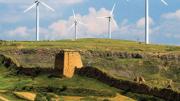Environmental scientists have concluded that China could meet its electricity needs through 2030 with wind power alone. In their study, the cover story in the September 11 issue of Science, lead author Michael McElroy, Butler professor of environmental studies, and colleagues from Tsinghua University, working as part of Harvard's China Project, conclude that a network of wind turbines operating at just 20 percent of their rated capacity could produce as much as seven times China's current consumption. China is currently second only to the United States in its national power-generating capacity, and is the world's fastest growing market for wind power. McElroy wrote a feature article for Harvard Magazine on the electrification of the United States's transportation infrastructure and the viability of wind power. His Harvard colleagues have also worked extensively on the problem of air pollution in China.
Powering China with Wind Alone
China could produce seven times its current electricity needs using wind alone.

You might also like
Building a New Information Civilization
Four women leading change in the world of privacy and personal data
Toward Reconciliation
Bereaved Palestinian and Israeli mothers visit Harvard.
Geopolitics and the Energy Transition
International relations during the shift to a net-zero economy
Most popular
Explore More From Current Issue
Why Taxi Drivers Don’t Die of Alzheimer’s
Explaining taxi and ambulance drivers’ protection against Alzheimer’s disease.








